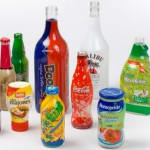
The use of sleeves on PET bottles may lead to errors in identification and reduction of separation of PET bottles by the Near Infrared (NIR) and optical detectors used in waste plastic packaging sorting and recovery plants. PET recyclers face additional problems because the sleeves are not removed in the pre-wash step of the recycling process. When sleeves pass through the pre-wash, they lead to a lower quality recycled PET. Full body sleeves in particular present a serious challenge to the identification of PET and hence problems in sorting and reduction in recovery processes.
To ensure efficient PET bottle identification and separation by colour, sleeves should not cover more than 70% of the surface of PET bottles of 500 ml and above; and not more than 50% for PET bottles of less than 500 ml. A sleeve that covers more than the recommended surface area is considered a full body sleeve. A full body sleeve shields PET bottles from optical detectors. This prevents a PET bottle from being correctly identified and/or sorted into the appropriate stream for recycling.
To overcome the growing issue with full-body sleeves on PET bottles requires a combination of actions by both industry and by consumers, for example, the use of sleeve perforations. The addition of twin perforations on the side of the sleeve allows consumers to remove the sleeve from the bottle before placing both the sleeve and the bottle into collection bins or bags. Clear instructions for consumers will encourage them to remove the sleeve thus facilitating accurate identification and sorting of the sleeveless PET bottle.
Additionally, removal of a sleeve could be perceived as a risk of plastic spreading in the environment if the sleeve is not disposed of correctly. For the time being this concept is unlikely to be suitable for bottles containing products that are expected to be consumed “on-the-go”.
Based on the above considerations, the Technical Committee of the European PET Bottle Platform (EBPB) has awarded a temporary endorsement to full body sleeves used on personal and household care bottles for a period of three years, provided the following conditions are met:
- The sleeve is equipped with double perforations which is designed to be easily identified and removed by consumers.
- The packaging Industry develops a standardised perforation concept, both in terms of functionality (easy tearing off operation) and design (immediate recognition), irrespective of the type and content of the PET bottle.
- To support the above, PET bottles with perforated sleeves must carry a standardised message for the consumer asking them to remove the sleeve from the bottle, and then place both the bottle and the sleeve in the collection bin or bag for recycling.
- The packaging Industry must support consumer cooperation with communication campaigns and provide data on the effectiveness of the consumer engagement.
- The PET bottle behind the sleeve must be compliant with the EPBP guidelines for transparent clear/light blue bottles and the sleeve should allow the recognition of the PET bottle, by polymer, if the sleeve is still present on the bottle before sorting.
Although perforations are intended to facilitate recycling of PET bottles with full body sleeves, it is desirable to use the same peroration system on bottles that carry partial coverage sleeves.
The EPBP Technical Committee accepts that perforation is not applicable to bottles that are required to keep the label on after disposal, for example, bottles belonging to deposit systems or bottles that contain regulated products.
The three-year period will be used to assess the packaging industry commitment in adopting the solution and to measure consumer engagement in removing the sleeves. This information will inform any decision to make the endorsement permanent.


